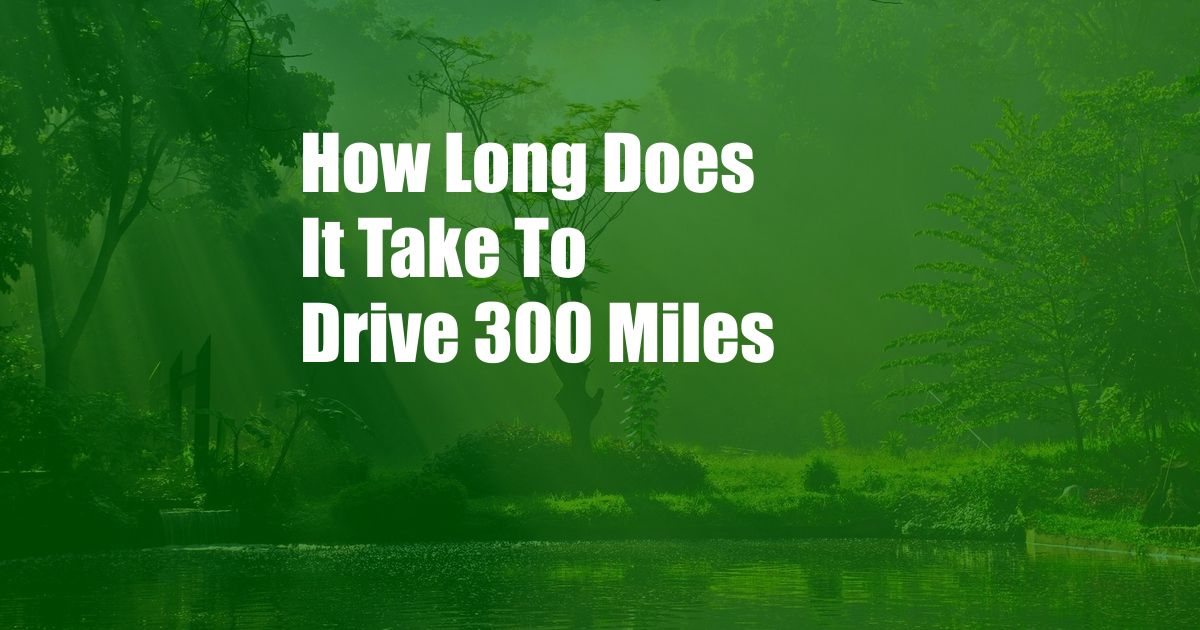
How Long Does It Take to Drive 300 Miles?
As a seasoned traveler, I’ve spent countless hours on the road, traversing various landscapes and experiencing the freedom that comes with hitting the open highway. One question that often arises during planning a long-distance road trip is: how long will it take to reach my destination? In this comprehensive guide, I’ll delve into the factors that influence driving time and provide an in-depth examination of how long it takes to drive 300 miles.
Before we embark on our journey, let’s address a common misconception: driving time is not solely dependent on the distance. It’s a complex calculation influenced by a multitude of variables, including traffic conditions, weather, road conditions, vehicle performance, and personal driving habits. Understanding these elements will empower you to make informed decisions and ensure a smooth and efficient road trip.
Factors Affecting Driving Time
When planning a long drive, consider the following factors that can significantly impact your travel time:
1. Traffic Conditions: Rush hour, construction zones, and special events can cause significant delays. Check traffic updates before your trip to avoid peak traffic periods and plan alternate routes if necessary.
2. Weather Conditions: Adverse weather, such as heavy rain, snow, or fog, can slow down traffic and reduce visibility. Adjust your driving speed and allow extra time for potential delays.
3. Road Conditions: Rough roads, potholes, and winding paths can increase driving time. Be mindful of road conditions and adjust your speed accordingly.
4. Vehicle Performance: The type of vehicle you drive can influence your driving time. Larger vehicles, such as SUVs and trucks, may require more time to accelerate and maneuver, while smaller cars can be more agile in traffic.
5. Personal Driving Habits: Your driving style can significantly impact your travel time. Aggressive driving, frequent stops, and a lack of attention can result in delays. Maintain a steady pace, minimize distractions, and plan for rest stops to ensure a safe and efficient journey.
Estimating Driving Time
Now that we’ve explored the factors affecting driving time, let’s focus on calculating the approximate time it takes to drive 300 miles. As a rule of thumb, you can expect to spend around 5 hours driving 300 miles without any major delays.
To calculate the driving time more precisely, consider the following formula:
Driving Time (hours) = Distance (miles) / Average Speed (miles per hour)
Assuming an average speed of 60 miles per hour, which accounts for potential delays, the driving time for 300 miles would be approximately 5 hours:
Driving Time = 300 miles / 60 miles per hour = 5 hours
Tips for Efficient Driving
To optimize your driving time and make your journey more enjoyable, consider these expert tips:
1. Plan Your Route: Before you hit the road, plan your route carefully, taking into account the factors discussed earlier. Consider using GPS or mapping apps to find the most efficient route and avoid potential delays.
2. Pack Smart: Minimize distractions and ensure a comfortable ride by packing your belongings securely. Use a cooler to keep drinks and snacks within reach, and consider entertainment options to keep yourself engaged during long stretches of driving.
3. Take Breaks: Regular breaks are crucial for maintaining alertness and preventing fatigue. Plan rest stops every few hours to stretch, grab a bite to eat, and refuel your vehicle.
Frequently Asked Questions
Q: What is the average driving speed in the United States?
A: The average driving speed on highways in the United States is around 60 miles per hour.
Q: How can I avoid traffic during my drive?
A: Check traffic updates before you leave and consider using alternative routes or traveling during off-peak hours to minimize delays.
Q: What should I do if I encounter bad weather while driving?
A: Reduce your speed and increase your following distance. Turn on your headlights and use your hazard lights if visibility is poor. If conditions become severe, pull over to a safe location and wait for the weather to improve.
Conclusion
Estimating driving time is a crucial aspect of planning any road trip, especially when covering long distances. By understanding the factors that influence driving time and following the tips provided, you can optimize your journey, ensure your safety, and enjoy the adventure that lies ahead. Remember, the open road awaits, beckoning you to explore and experience the freedom of driving.
Are you excited to embark on your next road trip? Share your thoughts and experiences in the comments below.